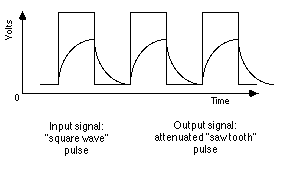This article outlines why higher data speeds, longer distances, “balanced circuits” and electrically “noisy” environments often require cables with enhanced performance characteristics.
Data Pulses Through Cable
Digital data in a cable is a complex stream of ultra-fast, precise voltage variations or pulses. The pulses form a language like Morse code that computer chips and integrated circuits can understand and manipulate. The biggest difference between yesterday’s Morse code and today’s computer data is speed. Morse code pulses ran at about 3 or 4 per second and most modern local area networks (LANs) operate at speeds up to 100 Mbps (100,000,000 bits per second). However, some are implementing Gigabit Ethernet (1000 Base T) which operates at 1000 Mbps.
High speed data pulses degrade or deteriorate when they are passed through any cable. Both the height of the pulse and the shape of the pulse change dramatically, and the amount of deterioration depends on the data rate, cable length, and cable electrical characteristics. If the output signal degrades too much, the computer system won’t recognize the data or will record false information. The same cable that works in short lengths may prove to be inadequate if used in longer lengths or at higher data speeds. The chart below illustrates the difference between an “input” chain of pulses and the “output” after traveling through a length of cable. The output has a much different shape and less magnitude.

The Importance of Capacitance
Cable capacitance is often the most critical electrical parameter when high speed data is transmitted. A high capacitance cable slows down the voltage rise time and decay time for each pulse, effectively distorting the data. The output signals begin to look like “saw-teeth” rather than the ideal “square wave” input. A lower capacitance cable always performs better with high speed data, providing less distortion. Low capacitance cables maintain the required wave shape and minimize possible data errors. For a more detailed discussion of electrical cable characteristics and specifically how cable capacitance is controlled, please refer to the Technology Briefs article entitled “Why is cable capacitance important for electronic applications?”
Special Low Capacitance Applications
Certain equipment systems and data processing environments require more exotic cable than Quabbin Wire’s standard low caps. EIA (Electronic Industries Association) RS-422 applications are one example. This standard defines equipment interconnections that use “balanced circuits” which require pairs of conductors that are isolated with their own grounding circuits. Low cap constructions with individually shielded pairs are often required.
Another application that may require different low cap cables is an electrically noisy environment, such as a typical factory floor. Large motors, high voltages and other high energy devices create severe electrical and magnetic fields that can interfere with sensitive digital data. For this reason, many computer aided design and computer aided manufacturing (CAD/CAM) systems use double shielded low capacitance cables for interconnection. These cables have an aluminum/polyester tape shield combined with a tinned copper braided shield. This combination provides both 100% shield coverage and excellent shielding effectiveness.
System designers must also consider the speed at which electronic signals transmit or propagate through the cable. High speed data that must travel longer distances can emerge unrecognizable at the output end. In these instances, cables with foam insulations are often specified. Quabbin Wire’s standard low cap cables use solid polyethylene insulation that has a velocity of propagation of 66%. This means that an electronic pulse travels through the cable at 66% of the speed of light. If this is not fast enough for the application, then foam polypropylene insulated low cap cables may be used. They propagate data signals at 78% velocity and have less signal distortion.
What Does Quabbin Wire Offer?
In summary, Quabbin Wire’s standard low capacitance cables are an excellent choice for most high speed data applications; however, certain environments or computer systems require enhanced low cap constructions. For this reason, Quabbin Wire manufactures and stocks a variety of double shielded and foamed insulation (high velocity) constructions. To view a range of specially designed low capacitance cables, check the following cable designs found in Quabbin Wire’s catalog:
| P/N | Description | Capacitance | Application |
|---|---|---|---|
| 8606 | 3 pair 24 AWG, pairs shielded | 12.5 pF/ft | RS 422 |
| 8312 | 6 pair 24 AWG, double overall shield | 12.8 pF/ft | CAD/CAM |
For more information or to comment on this article, contact engineering@quabbin.com.

